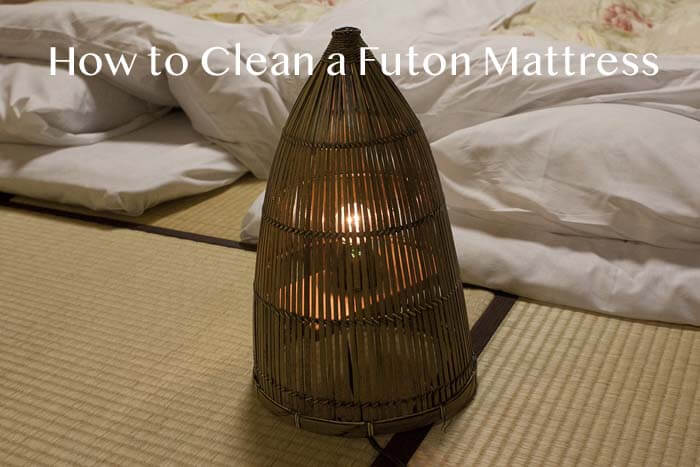How to Clean a Futon Mattress
by | Last Updated
Many people love futon mattresses for their convenient size and versatility. But because futons are made for both sitting and sleeping, they also lose their fresh look a lot faster.
The good news is, you can prevent your futon from turning into a piece of stained cloth!
Here are a few tips on how to clean a futon mattress so that it would maintain its good shape and look longer. Enjoy!
How to Clean a Futon Mattress with a Vacuum?
Let’s begin with the easiest way possible.
If your futon mattress is relatively new and doesn’t have any stains or spills, all you need to keep it this way is a vacuum.
Now, a little disclaimer before we proceed:
Before starting any cleaning activities, be sure to learn about the manufacturer’s guidelines on care and maintenance. Some futons may have specific cleaning instructions, and you should follow them through to keep your warranty valid.
Still, vacuum-cleaning applies to most futon mattresses.
So, grab your vacuum and let it do the job. I will point out just some recommendations that will make your cleaning even better:
- Be sure to flip the futon and vacuum another side too.
- It’s better to clean a futon mattress when it’s unfolded (e.g. lying flat on the floor). However, if you don’t want to spread out your sofa, at least use the brush attachment to get into every corner.
- Vacuum your futon regularly: 1-2 times per month should be fine for maintaining a fresh look.
“Vacuum cleaning is the best way to get rid of possible allergens, such as dust mites and tiny debris that might build up inside your futon.”
Removing Any Unpleasant Smells
The second most common concern for the owners of futon beds is how to remove odor. Active exploitation causes funky smells to develop, and it’s certainly not a thing you want to feel every night when sleeping. 
So, below are my recommendations on how to effectively remove odors from a futon mattress.
- Baking soda. The most effortless way to deodorize your futon mattress is to use baking soda. Unfold the futon and sprinkle it generously with baking soda. Then, let it sit for about an hour so that it would absorb odors. Finally, vacuum your futon mattress to gather all of the baking soda and enjoy the freshness.
- Steamer. If the odor is strong or persists after the soda treatment, you may want to use a steamer to blow steam through the futon mattress. However, check the manufacturer’s instruction first, as some brands won’t allow the use of hot water steam on their products.
- Aeration. Finally, leave your futon without bedding and covers and let it soak some fresh air in. Ventilation will allow the moisture that might have been left from your body to evaporate so that the smells won’t annoy you. Also, if you expose your futon mattress to sunlight a bit, this will kill the dust mites.
“You can use essential oils, such as peppermint or lemon, as a quick solution. To avoid oily stains, mix a couple of drops of oils with water and add to a pulverizer; then, sprinkle over your futon.”
How to Clean a Futon Mattress from Stains?
Now, let’s move to the wet methods of cleaning your futon. Again, always check the care and maintenance tips provided to you by the manufacturer first.
The universal solution for removing stains and spills is warm water with soap or mild detergent (you can use dish soap for oily stains).
Here is my advice for you:
- Try to remove the stains as soon as possible. If you allow some liquids, such as coffee or berry juices, to dry out, it will become nearly impossible to clean them.
- Test your cleaning solution first. Some detergents might bleach the fabric, so choose an unnoticeable spot and apply them to see if it works.
- Don’t soak your futon. Too much liquid may contribute to mildew. Instead, use blotting movements and don’t spread the cleaning solution too far from the spot.
“If you accidentally soaked your mattress, you can use a blow dryer to evaporate some liquid. After that, allow your futon to dry naturally.”
How Else Can You Care for Your Futon?
Proper care isn’t limited only to regular cleaning. To prolong the lifespan of your futon mattress, you can also do the following:
- Rotate your futon regularly. Rotating your mattress will help prevent indentations and slow down the sagging process.
- Put a cover on it. Futon covers are typically made of thicker and more durable materials than standard bedding. Also, they often are washable, which makes the maintenance of your futon mattress much easier. So, you may want to purchase a couple of covers and switch between them.
Cleaning Hacks for Shikibuton Owners
A shikibuton is a more classic type of futon, which is traditional for Japan. It looks like it has more padding and is used primarily for sleeping.
If you’re an owner of a shikibuton, I have great news for you:
Most of these mattresses (except for those with feather fill) can be washed in a washing machine!
However, you still have to ensure it’s not against the manufacturer’s guidelines. In case it’s allowed, here are some helpful tips to make your shikibuton cleaning easier:
- Use a laundromat. Most household washing machines typically have a load capacity of 11-14 lbs, which might be not enough to fit a futon. A laundromat may come in handy here, as it’s much larger.
- Put your futon in an encasement. The encasement will ensure that your futon won’t unfold and will be washed evenly. Also, the encasement will protect your futon from accidental damaging inside the washer.
- Use delicate mode. If your washing machine has a ‘handwashing’ mode, you can choose it as well. And make sure that the water temperature is not higher than 30-40C.
After washing your Japanese futon, allow it to dry completely. You can either put it outside, if the weather is sunny, or use a tumble dryer on the lowest setting.
Do you have your own tips on how to clean a futon? Feel free to share them below!





No Comments